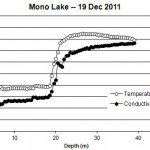
In January Mono Lake rose 1/4 foot, and it has continued rising at a slower rate in February to today’s level of 6383.9 feet above sea level. This brings it to within 0.06 feet of the mid-August 2011 highpoint (the highest level since 2007). It should keep rising for another month before it begins dropping in April due to the dry year. Dave Marquart with the Mono Lake Tufa State Natural Reserve says he will probably have to reroute a section of the South Tufa trail to higher ground before April.
Snow surveys find snow–barely
February 1 snow surveys found very low and dramatically varying snow water content in the headwaters of Mono Lake’s tributary streams. The lowest snow water content along Rush Creek was at Gem Pass, where only 5.4 inches was measured—the fourth lowest February 1 total since 1.7 inches in 1991, 5.0 inches in 1987, and 2.7 inches in 1977. It was the sixth lowest water content ever measured on any date at that location. You can check for updates here, however be aware the Cain Ranch precipitation total is an inch or two too low due to a power outage in January. We have also updated our Lee Vining Internet weather station data (which differs slightly from the official NOAA data).
At the other end of the spectrum, the Ellery Lake snow course on Lee Vining Creek measured 8 inches of water content, where it was lower 15 times in history, and seven times on February 1: 1994–6″, 1991–2.2″, 1987–5.2″, 1977–3.8″, 1976–4.5″, 1960–6.6″, 1959–7.2″. This pattern is primarily due to a single storm in January. All this adds up to a preliminary runoff forecast of 41%—tied with 1977 for the driest year on record.

Meromixis returns
According to UCSB researcher Dr. Robert Jellison, during the December 19 limnology monitoring survey, Mono Lake was chemically stratified—a condition called meromixis. On February 16 it was still stratified into a less-saline upper layer (80.9 g/l above 14 meters deep—with even fresher water in the upper 2 meters) and a more-saline lower layer (gradually increasing to 82.7 g/l at the bottom 39 m deep). The temperature also increased from 2.7 C in the mixolimnion (upper layer) and 4.8 C near the bottom in the monimolimnion (lower layer).
Mono Lake usually thermally stratifies during summer and mixes fully from top to bottom during the winter—it is a monomictic lake (with “mono” pronounced not like our lake but like the disease). When it is meromictic—failing to mix during the winter—nutrients remain trapped in the monimolimnion, causing a short-term decrease in productivity in the lake ecosystem.
A dry year this year will likely make this stratification break down by next winter. Dr. Jellison points out that while this would be the shortest of the three periods (8 years, 5 years, and 2 years) of meromixis observed in Mono Lake during the 30-year limnology monitoring program, it is likely that a one-year period of meromixis happened numerous times in the past.

Greg, this is based on some great material but you really must a get a grip on your use of mixed units, and your curious handling of feet and inches. What is .9 feet expressed in inches?
Why isn’t MLC a leader in this kind of reporting? Why not do the whole lot in the international standards. Why, you have such a hodgepodge of metres and litres and deciumal points of feet and inches that this man needs to take a shower to settle the brain, and that even when London is in near drought state after two long dry winters.
MLC reporting of science is not good for the water table in two continents.
Hi Roger,
This is written for an American audience, which can handle this sort of thing :). Note that the data from academia is metric, while the other hydrology data is decimal English, and the meteorology data is in inches. This is all standard and designed to keep you on your toes (and in your low-flow shower). I must admit I felt a tinge of guilt not converting the metric lake levels to feet. Thank you for pointing this out about this article–next time I’ll try harder to be consistent within each category.
And to answer your question, .9 feet is 1.2 inches less than 12 inches. It is also 27.4 centimeters and 0.27 meters. Hopefully the productivity lost in the US economy from converting units is made up for by increased employment resulting from its side-effects–probably developing new water conservation devices for increases in showering.